Uncategorized
Why The SEC Needs to Allow Staking in Exchange-Traded Products
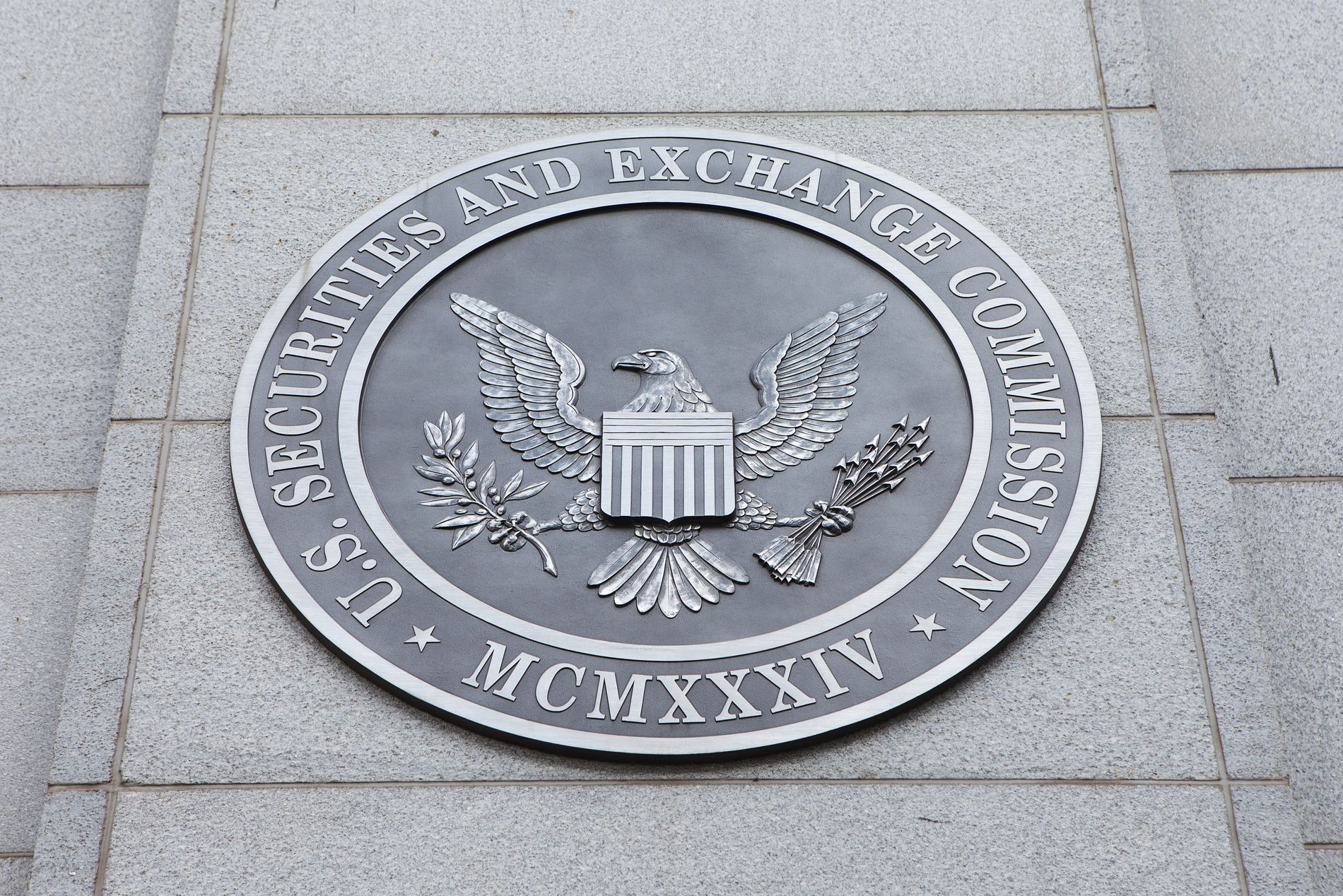
For far too long, the U.S. has been falling behind the rest of the world on staking policy. Now, in just the first 30 days of the Trump Administration, staking has been mentioned in Congressional hearings, listed as a top priority by the SEC’s newly created crypto task force and is today the focus of a bipartisan letter from lawmakers challenging the previous SEC’s stance on its inclusion in exchange-traded products (ETPs). Many in the digital asset sector celebrated when the first spot ether ETFs were approved in September of last year. It was a giant leap forward for the second-largest cryptocurrency, achieving legitimacy in the eyes of U.S. regulators. But there has been one glaring omission within these financial products: the ability to stake the held assets and profit by doing so.
Now a bipartisan group of lawmakers including Senators Cynthia Lummis (R-WY), Kirsten Gillibrand (D-NY), Steve Daines (R-Montana), Bill Hagerty (R-Tenn.), Thom Tillis (R-NC), Bernie Moreno (R-Ohio) and Ron Wyden (D-OR) is leading the way to correct that. In a letter delivered to the Securities and Exchange Commission on Friday, they are challenging the SEC’s directive to exclude protocol staking in ETPs, highlighting how this position could undermine both investor protections and the competitiveness of U.S. markets.
The SEC’s prohibition on staking within ETPs is based on a faulty understanding of how staking works on proof-of-stake networks like Ethereum. Staking is not an investment product in itself. Rather, it is a fundamental technical requirement for securing and validating transactions on proof-of-stake networks. When token holders stake their assets, they contribute to the network’s security, and in doing so earn rewards generated by the protocol itself — not from any centralized authority.
International competitiveness
The SEC’s directive to spot ether ETP issuers to exclude staking raises serious concerns about America’s competitive position in global digital asset markets. While the United States hesitates, other major financial centers including Switzerland, Canada, Germany and Australia have embraced staking in their digital asset ETPs, recognizing its integral role in network security and operational stability. Just last month, the U.K. issued a statutory instrument acknowledging that arrangements for qualifying crypto asset staking do not amount to a collective investment scheme, reinforcing its importance in securing and maintaining blockchain networks.
Because staking is essential for securing proof-of-stake networks, it also means that if there were no one staking their ether, then all of the assets within these ETPs would be at risk. This means that, perversely, the SEC has forced American investors into a position where their investments are only protected by assets held in other jurisdictions.
Crucially, the impact of these regulations extends beyond just the Ethereum blockchain, but applies to possible future ETPs of other networks that also use proof-of-stake such as Solana, Avalanche and Polkadot. As the digital asset sector grows, the impact of this misguided regulation will only deepen.
Getting this regulation wrong hurts both American investors and the U.S. economy. Either investors accept domestic products without staking and the associated rewards, limiting their financial returns, or they seek exposure through off-shore alternatives, driving capital offshore and out of U.S. stock exchanges. Without staking, ether ETP holders gradually lose their relative network ownership position due to the inflationary nature of staking rewards.
This economic reality makes U.S. products less competitive and less attractive to investors seeking comprehensive exposure to the Ethereum ecosystem. Even more troubling, this outcome appears to contradict the SEC’s core mission of investor protection, likely pushing investors toward investment vehicles in other jurisdictions that may not meet the investor protection standards available to investors in the U.S.
The technical risks associated with staking, when managed by sophisticated validators, are minimal and well-understood. The often-cited «slashing risk» — a penalty mechanism for dishonest validation attempts — has affected just 0.001 percent of staked ether to date. This data suggests that the SEC’s cautious stance may be disproportionate to the actual risks involved.
What’s at stake
As we await the SEC’s response to the important questions raised by Congress, American investors continue to be at a distinct disadvantage. The path forward requires a balanced approach that recognizes staking for what it is — a technical mechanism for network security — while ensuring there is appropriate oversight when it is offered within regulated investment products.
As the letter rightly points out, while only Congress can create a comprehensive regulatory framework, the SEC has the authority to permit staking in ETPs. Doing so would align with both the agency’s mandate to protect investors and the goal of maintaining U.S. leadership in global financial markets.
The bipartisan Congressional letter to SEC Commissioners Uyeda and Peirce endorsing Protocol Staking in Digital Asset ETPs is a significant milestone for investors – both crypto native and institutional. With Uyeda having criticized what he has called the “weaponization” of the SEC’s enforcement functions and crypto advocate Paul Atkins being nominated to take over the role of SEC Chair, we have a rare opportunity to make progress on one of the most common sense issues in the digital asset landscape.
It’s beyond time for the SEC to assume a leadership position when it comes to protocol staking, which powers the digital asset sector. This befits the aspirations of the American economy and the Americans who rely on it.
Uncategorized
XLM Sees Heavy Volatility as Institutional Selling Weighs on Price
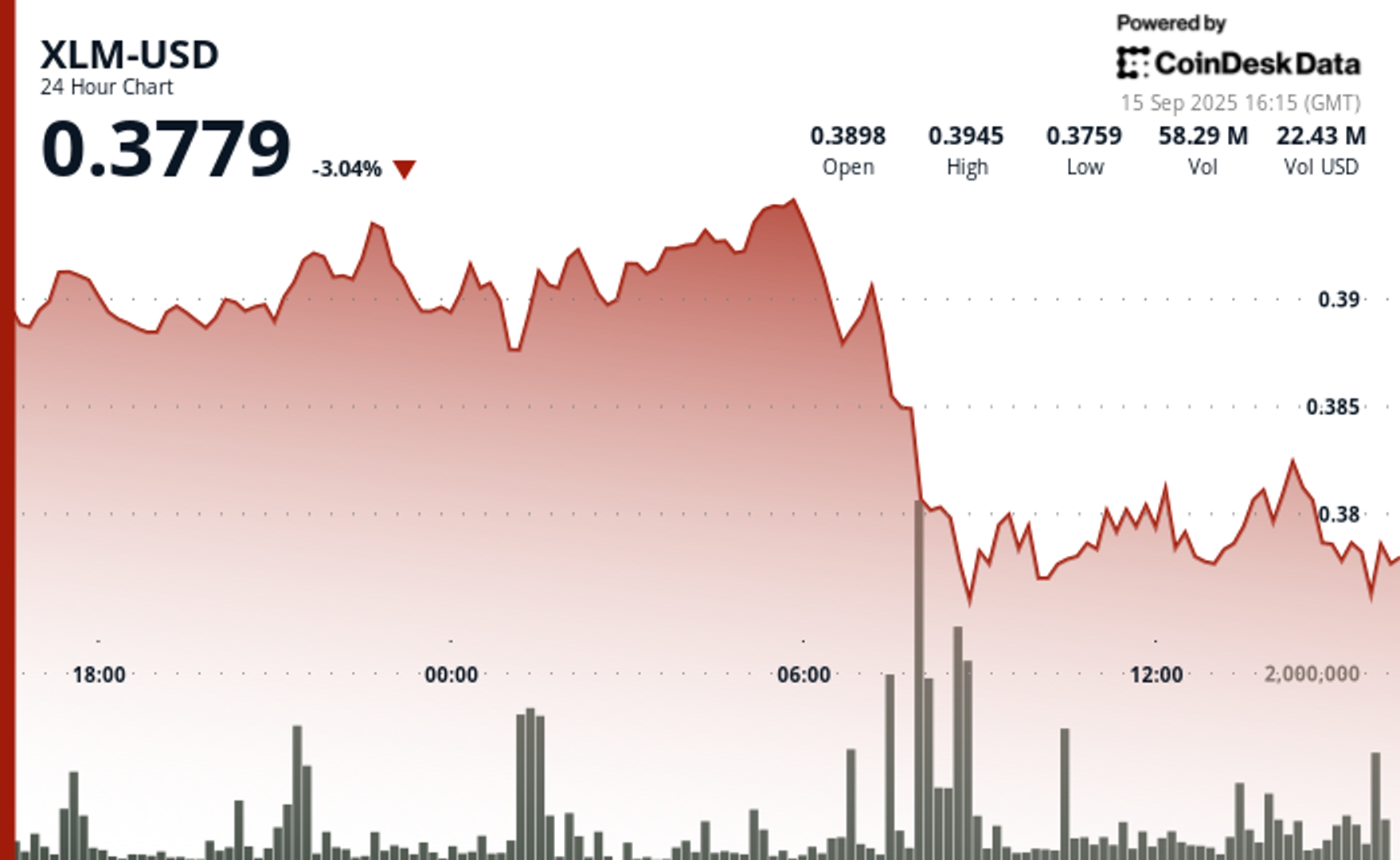
Stellar’s XLM token endured sharp swings over the past 24 hours, tumbling 3% as institutional selling pressure dominated order books. The asset declined from $0.39 to $0.38 between September 14 at 15:00 and September 15 at 14:00, with trading volumes peaking at 101.32 million—nearly triple its 24-hour average. The heaviest liquidation struck during the morning hours of September 15, when XLM collapsed from $0.395 to $0.376 within two hours, establishing $0.395 as firm resistance while tentative support formed near $0.375.
Despite the broader downtrend, intraday action highlighted moments of resilience. From 13:15 to 14:14 on September 15, XLM staged a brief recovery, jumping from $0.378 to a session high of $0.383 before closing the hour at $0.380. Trading volume surged above 10 million units during this window, with 3.45 million changing hands in a single minute as bulls attempted to push past resistance. While sellers capped momentum, the consolidation zone around $0.380–$0.381 now represents a potential support base.
Market dynamics suggest distribution patterns consistent with institutional profit-taking. The persistent supply overhead has reinforced resistance at $0.395, where repeated rally attempts have failed, while the emergence of support near $0.375 reflects opportunistic buying during liquidation waves. For traders, the $0.375–$0.395 band has become the key battleground that will define near-term direction.
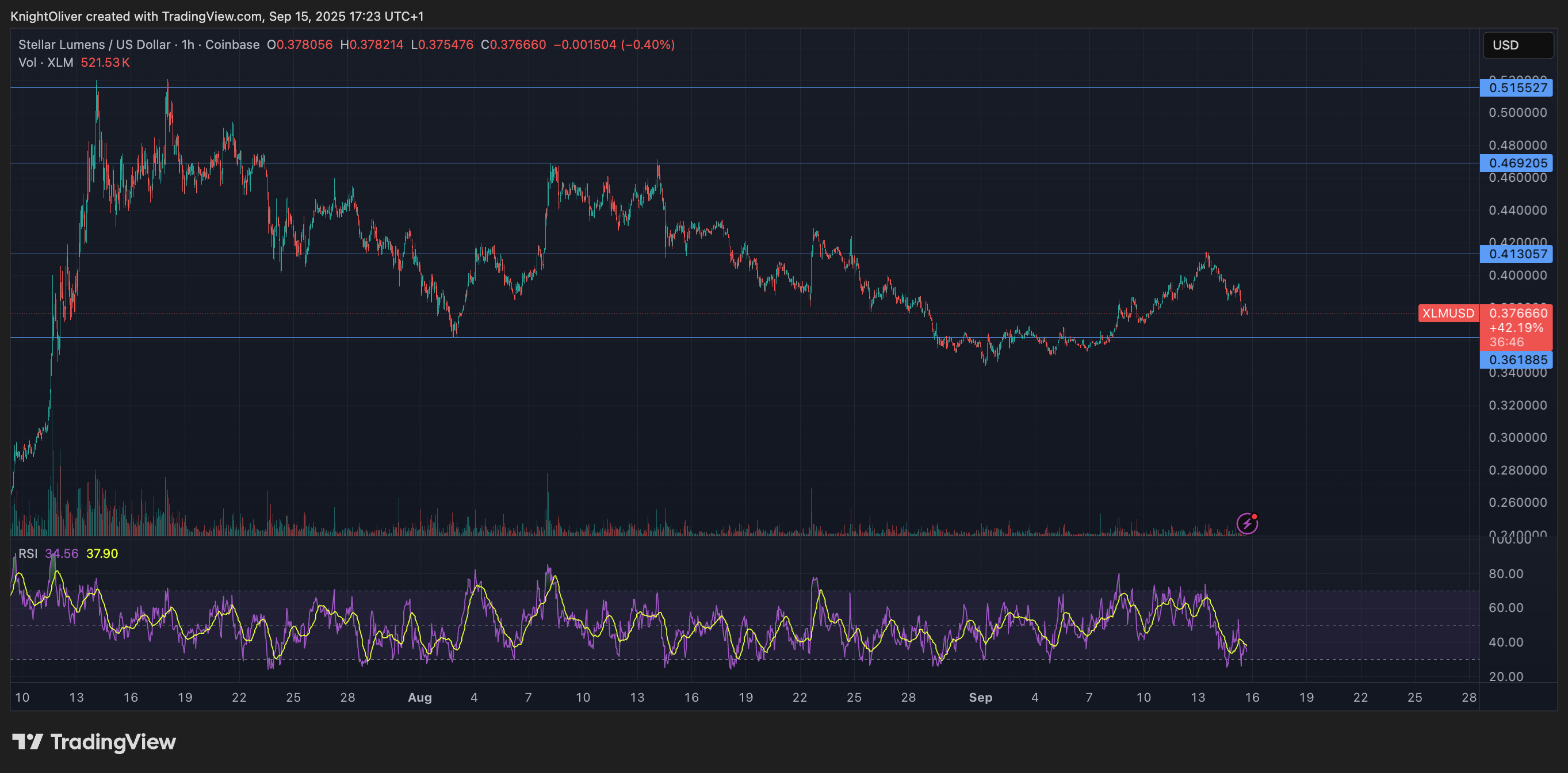
Technical Indicators
- XLM retreated 3% from $0.39 to $0.38 during the previous 24-hours from 14 September 15:00 to 15 September 14:00.
- Trading volume peaked at 101.32 million during the 08:00 hour, nearly triple the 24-hour average of 24.47 million.
- Strong resistance established around $0.395 level during morning selloff.
- Key support emerged near $0.375 where buying interest materialized.
- Price range of $0.019 representing 5% volatility between peak and trough.
- Recovery attempts reached $0.383 by 13:00 before encountering selling pressure.
- Consolidation pattern formed around $0.380-$0.381 zone suggesting new support level.
Disclaimer: Parts of this article were generated with the assistance from AI tools and reviewed by our editorial team to ensure accuracy and adherence to our standards. For more information, see CoinDesk’s full AI Policy.
Uncategorized
HBAR Tumbles 5% as Institutional Investors Trigger Mass Selloff
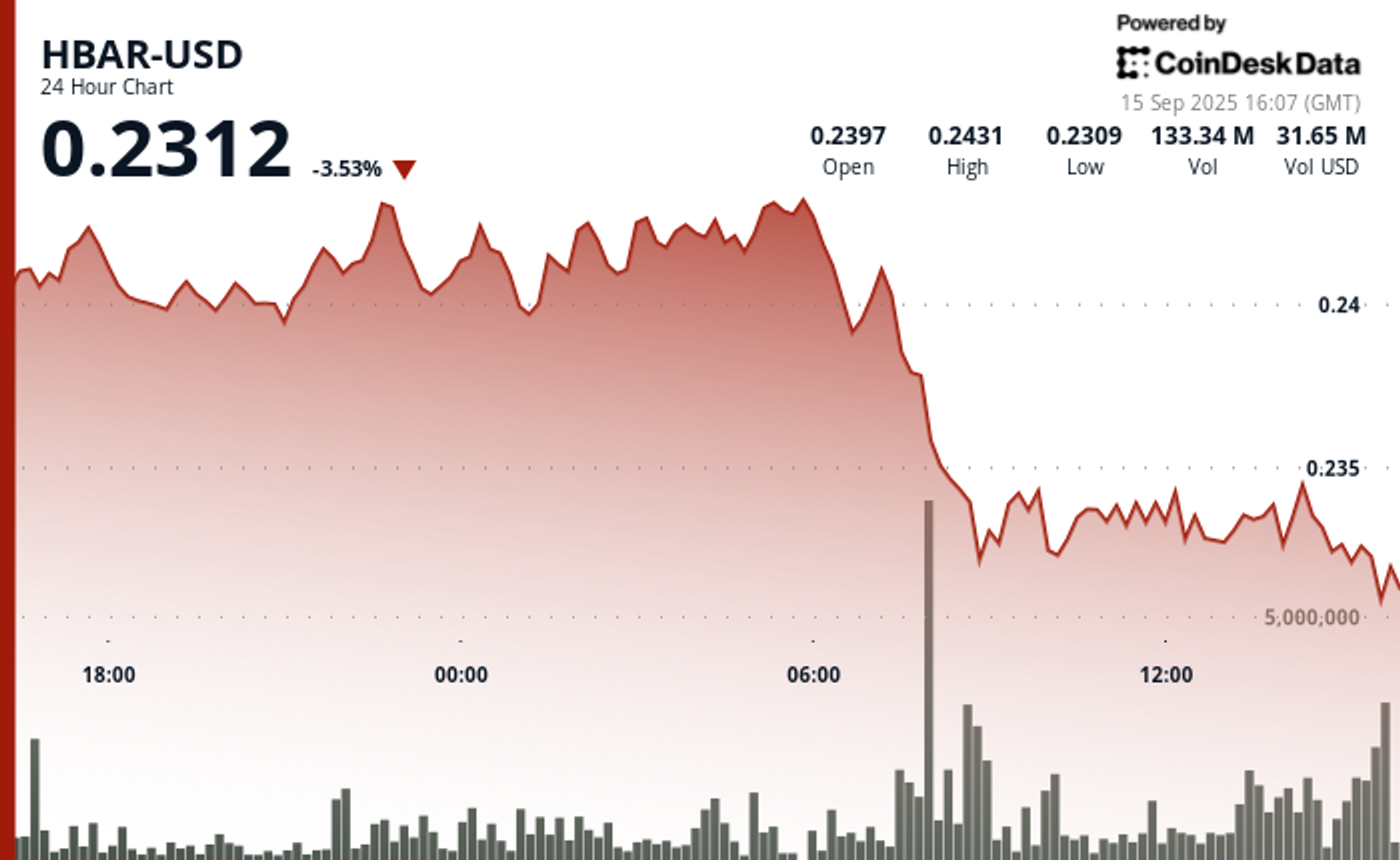
Hedera Hashgraph’s HBAR token endured steep losses over a volatile 24-hour window between September 14 and 15, falling 5% from $0.24 to $0.23. The token’s trading range expanded by $0.01 — a move often linked to outsized institutional activity — as heavy corporate selling overwhelmed support levels. The sharpest move came between 07:00 and 08:00 UTC on September 15, when concentrated liquidation drove prices lower after days of resistance around $0.24.
Institutional trading volumes surged during the session, with more than 126 million tokens changing hands on the morning of September 15 — nearly three times the norm for corporate flows. Market participants attributed the spike to portfolio rebalancing by large stakeholders, with enterprise adoption jitters and mounting regulatory scrutiny providing the backdrop for the selloff.
Recovery efforts briefly emerged during the final hour of trading, when corporate buyers tested the $0.24 level before retreating. Between 13:32 and 13:35 UTC, one accumulation push saw 2.47 million tokens deployed in an effort to establish a price floor. Still, buying momentum ultimately faltered, with HBAR settling back into support at $0.23.
The turbulence underscores the token’s vulnerability to institutional distribution events. Analysts point to the failed breakout above $0.24 as confirmation of fresh resistance, with $0.23 now serving as the critical support zone. The surge in volume suggests major corporate participants are repositioning ahead of regulatory shifts, leaving HBAR’s near-term outlook dependent on whether enterprise buyers can mount sustained defenses above key support.
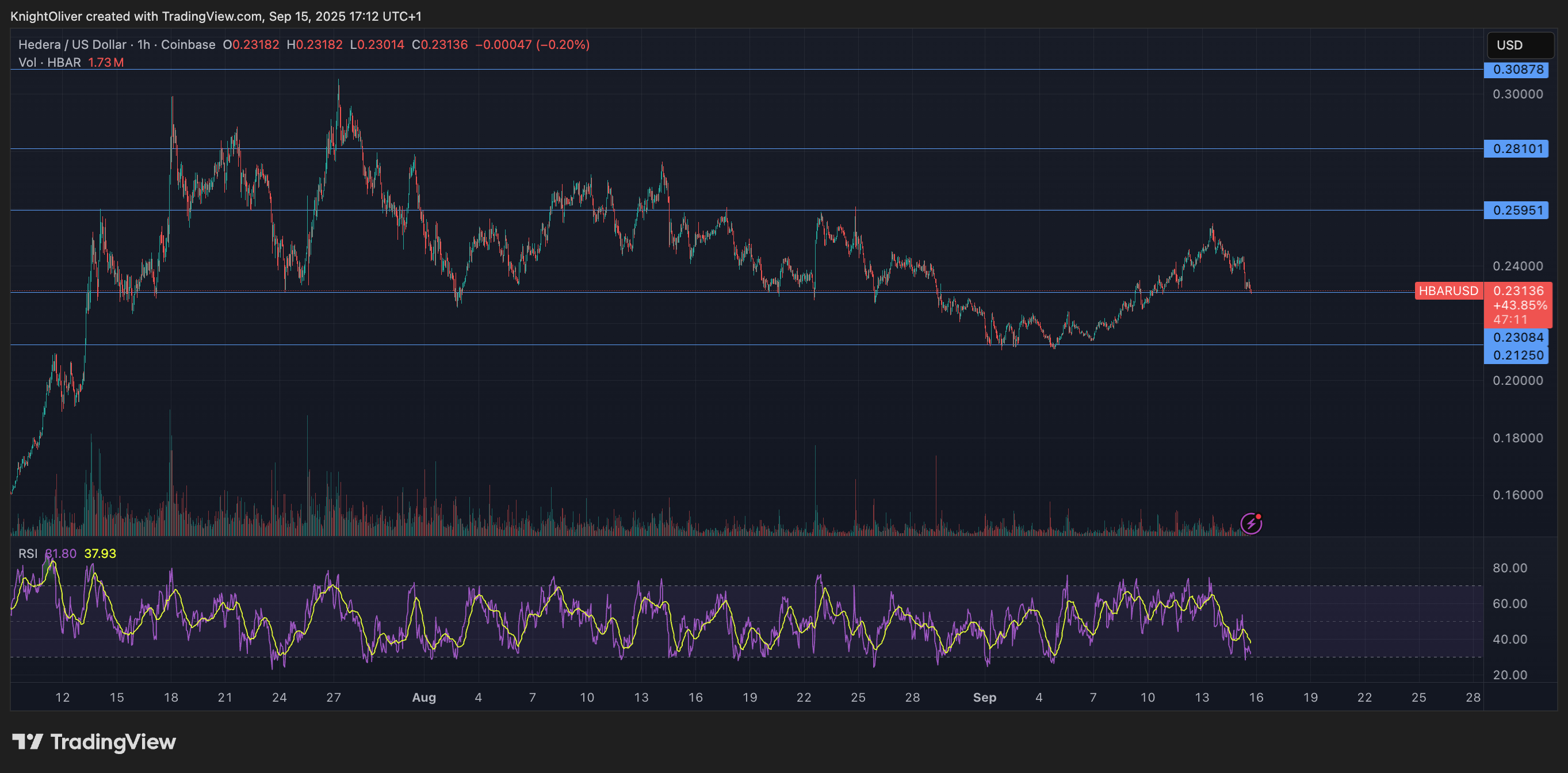
Technical Indicators Summary
- Corporate resistance levels crystallized at $0.24 where institutional selling pressure consistently overwhelmed enterprise buying interest across multiple trading sessions.
- Institutional support structures emerged around $0.23 levels where corporate buying programs have systematically absorbed selling pressure from retail and smaller institutional participants.
- The unprecedented trading volume surge to 126.38 million tokens during the 08:00 morning session reflects enterprise-scale distribution strategies that overwhelmed corporate demand across major trading platforms.
- Subsequent institutional momentum proved unsustainable as systematic selling pressure resumed between 13:37-13:44, driving corporate participants back toward $0.23 support zones with sustained volumes exceeding 1 million tokens, indicating ongoing institutional distribution.
- Final trading periods exhibited diminishing corporate activity with zero recorded volume between 13:13-14:14, suggesting institutional participants adopted defensive positioning strategies as HBAR consolidated at $0.23 amid enterprise uncertainty.
Disclaimer: Parts of this article were generated with the assistance from AI tools and reviewed by our editorial team to ensure accuracy and adherence to our standards. For more information, see CoinDesk’s full AI Policy.
Uncategorized
Dogecoin Inches Closer to Wall Street With First Meme Coin ETF
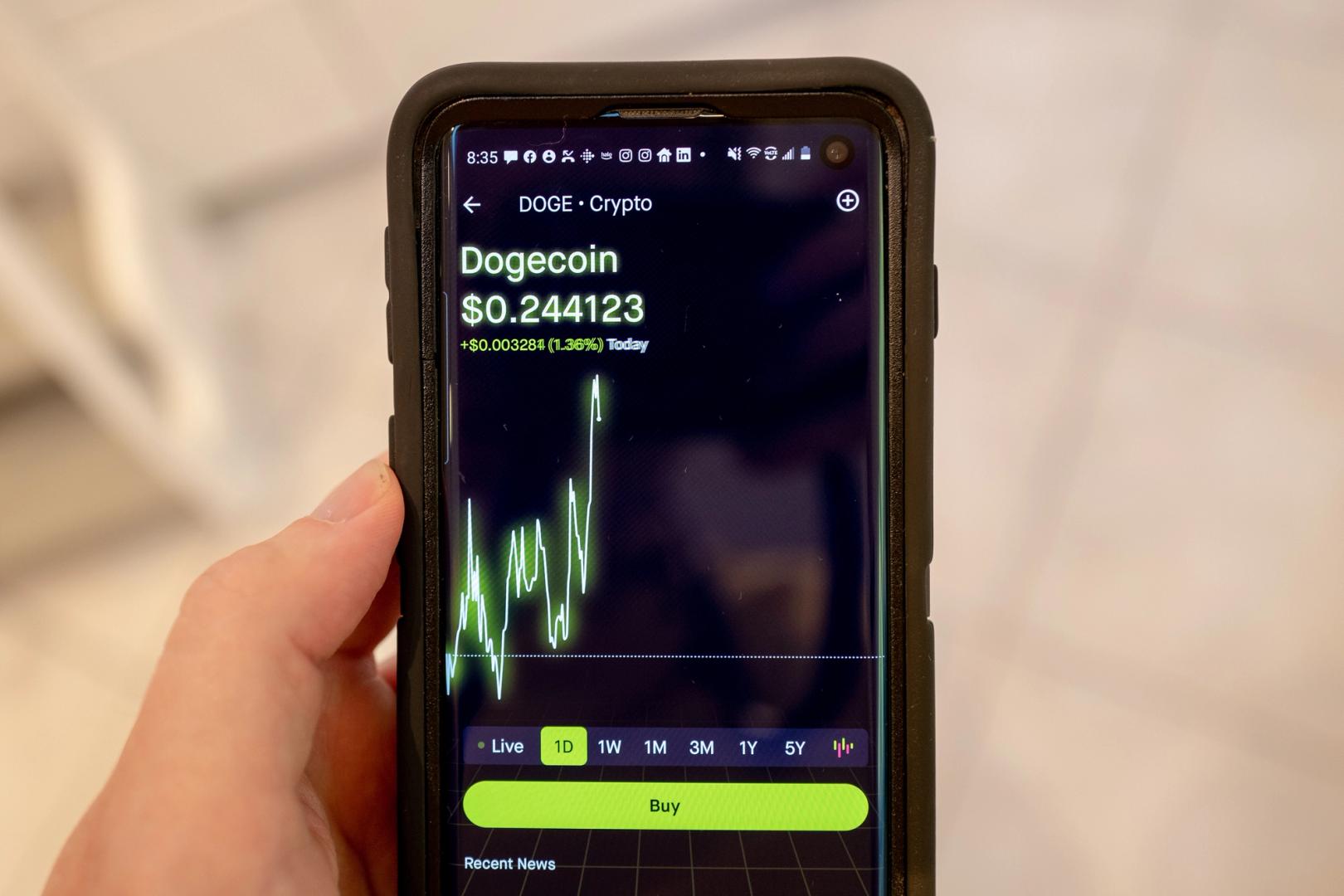
The first exchange-traded fund (ETF) built around a meme coin could hit the market this week, after multiple delays and much speculation.
The DOGE ETF — formally called the Rex Shares-Osprey Dogecoin ETF (DOJE) — was originally slated to debut last week, alongside a handful of politically themed and crypto-related ETFs. Those included funds tied to Bonk (BONK), XRP, Bitcoin (BTC) and even a Trump-themed fund. But DOJE’s debut never materialized.
Now, Bloomberg ETF analysts Eric Balchunas and James Seyffart believe Wednesday is the most likely launch date, though they caution nothing is certain.
“It’s more likely than not,” Seyffart said. “That seems like the base case.”
Ahead of the introduction of the ETF, DOGE has been among the top performers over the past month, ahead 15% even including a decline of 3.5% over the past 24 horus.
If launched, DOJE would mark a milestone as the first U.S. ETF to focus on a meme coin — cryptocurrencies that generally lack utility or a clear economic purpose. These include tokens like Dogecoin, Shiba Inu (SHIB) and Bonk, which often surge in popularity thanks to internet culture, celebrity endorsements and speculative trading.
Balchunas described DOJE’s significance in a post on X: “First-ever US ETF to hold something that has no utility on purpose.”
DOJE is not a spot ETF. That means it won’t hold DOGE directly. Instead, the fund will use a Cayman Islands-based subsidiary to gain exposure through futures and other derivatives. This approach sidesteps the need for physical custody of the coin while still offering traders a way to bet on its performance within a traditional brokerage account.
The ETF was approved earlier this month under the Investment Company Act of 1940, which is typically used for mutual funds and diversified ETFs. That sets it apart from the wave of bitcoin ETFs that received green lights under the Securities Act of 1933, a framework used for commodity-based and asset-backed products. In short, DOJE is structured more like a mutual fund than a commodity trust.
More direct exposure may be coming soon. Several firms have filed applications to launch spot DOGE ETFs, which would hold the meme coin itself rather than derivatives. These applications are still under review by the U.S. Securities and Exchange Commission (SEC), which has grown more comfortable with crypto ETFs since approving a slate of bitcoin products in early 2024.
The broader crypto market has shown that investor demand can outweigh fundamental critiques. Meme coins have long drawn skepticism for having no underlying value or use case, but that hasn’t kept them from drawing billions in speculative capital.
Seyffart said the ETF market is likely to follow the same path. “There’s going to be a bunch of products like this, whether you love it or need it, they’re going to be coming to market,” he said.
He added that many existing financial products serve no deeper purpose than providing a vehicle for short-term bets. “There’s plenty of products out there that are just being used as gambling or short-term trading,” he said. “So if there’s an audience for this in the crypto world, I wouldn’t be surprised at all if this finds an audience in the ETF and TradFi world.”
Whether the DOJE ETF opens the door to more meme coin funds — or just proves the concept is viable — may depend on how the market responds this week. Either way, it signals a new phase in the merging of internet culture and traditional finance.
-

 Business11 месяцев ago
Business11 месяцев ago3 Ways to make your business presentation more relatable
-

 Fashion11 месяцев ago
Fashion11 месяцев agoAccording to Dior Couture, this taboo fashion accessory is back
-

 Entertainment11 месяцев ago
Entertainment11 месяцев ago10 Artists who retired from music and made a comeback
-

 Entertainment11 месяцев ago
Entertainment11 месяцев ago\’Better Call Saul\’ has been renewed for a fourth season
-

 Entertainment11 месяцев ago
Entertainment11 месяцев agoNew Season 8 Walking Dead trailer flashes forward in time
-

 Business11 месяцев ago
Business11 месяцев ago15 Habits that could be hurting your business relationships
-

 Entertainment11 месяцев ago
Entertainment11 месяцев agoMeet Superman\’s grandfather in new trailer for Krypton
-

 Entertainment11 месяцев ago
Entertainment11 месяцев agoDisney\’s live-action Aladdin finally finds its stars





